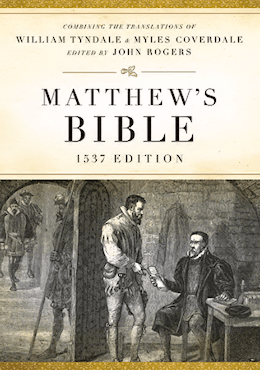Textus Receptus Bibles
Matthew's Bible 1537
| 41:1 | Darrest thou drawe out Leuyathan wt an angle, or bynde hys tonge with a snare? |
| 41:2 | Canste thou put a rynge in the nose of hym, or bore hys chaftes thorow wt a naule. |
| 41:3 | Wil he make many fayre wordes wyth the (thinckest thou) or flattre the? |
| 41:4 | Wyll he make a couenaunt wyth the? Or art thou able for to compel him to do the contynuall seruyce? |
| 41:5 | Wylt thou take thy pastyme wyth hym as with a byrd, or geue him vnto thy maydens, |
| 41:6 | that thy companyons maye hewe hym in peces, to be parted amonge the marchaunt men? |
| 41:7 | Canste thou fyl the net with his skinne, or the fyshe pannyer with hys heade? |
| 41:8 | Darrest thou laye hande vpon him? It is better for the to consydre what harme might happen the there thorow & not to touche hym. |
| 41:9 | For when thou thinkest to haue hold vpon hym, he shall begyle the: Euery man also that seyth hym, shal go backe. And why? |
| 41:10 | there darre none be so bolde as to rayse hym vp. Who is able to stande before me? |
| 41:11 | Or, who hath geuen me anye thynge afore hande, that I am bound to reward hym againe? All thynges vnder heauen are myne. |
| 41:12 | I feare hym not, whether he threaten or speake fayre. |
| 41:13 | Who lyfteth hym vp, & strypeth hym out of hys clothes, or who taketh him by the byt of hys brydle? |
| 41:14 | Who openeth the dore of hys face? for he hath horryble tethe rounde aboute. |
| 41:15 | Hys body is couered with scales as it were wyth shyldes, lockt in, kepte, & wel compacte together. |
| 41:16 | One is so ioyned to another, that no ayre can come in |
| 41:17 | Yea one hangeth so vpon another, & stycketh so together, that they can not be sundered. |
| 41:18 | His nesynge is lyke a glysteryng fyre, & his eyes lyke the morning shyne. |
| 41:19 | Oute of hys mouthe go torches & fyre brandes |
| 41:20 | oute of hys nostrels there goeth a smoke, like as oute of an hote sethinge pot. |
| 41:21 | His breth maketh the cotes burne, the flamme goeth out of hys mouth. |
| 41:22 | In his necke remayneth strength & before hys face sorow is turned to gladnes. |
| 41:23 | The membres of his body are ioyned so strait one to another, and cleue so fast together, that he can not be moued. |
| 41:24 | His hert is as herde as a stone, & as faste as the stithye that the hammer man smyteth vpon. |
| 41:25 | When he goeth, the myghtiest of al are afrayed, & the waues heauy. |
| 41:26 | If he drawe out the swearde, there maye neyther speare nor brest plate, abyde hym |
| 41:27 | He setteth as much by a strawe as by yron, and as muche by a rotten stocke as by metall. |
| 41:28 | He starteth not away for hym that bendeth the bowe: & as for slynge stones, he careth as muche for stubble as for them. |
| 41:29 | He counteth the hammer no better then a strawe, he laugheth hym to scorne that shaketh the speare. |
| 41:30 | He treadeth the golde in the myre lyke the sharpe potsherdes. |
| 41:31 | He maketh the depe to seethe and boyle lyke a pot, & stereth the sea together lyke an oyntment. |
| 41:32 | The waye is lyght after hym, the depe is hys walkynge place. |
| 41:33 | Vpon earth is there no power lyke vnto hys, for he is so made that he feareth not. |
| 41:34 | If a man wyll consydre all hye thinges, thys same is a kynge ouer all the chyldren of pryde. |

Matthew's Bible 1537
The Matthew Bible, also known as Matthew's Version, was first published in 1537 by John Rogers, under the pseudonym "Thomas Matthew". It combined the New Testament of William Tyndale, and as much of the Old Testament as he had been able to translate before being captured and put to death, with the translations of Myles Coverdale as to the balance of the Old Testament and the Apocrypha, except the Apocryphal Prayer of Manasses. It is thus a vital link in the main sequence of English Bible translations.